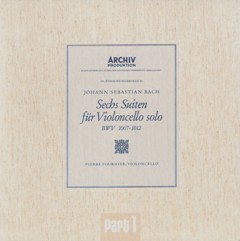111 Years of Deutsche Grammophon - CD 14
111 Years of Deutsche Grammophon - CD 14
Bach, J.S.: Cello Suites Nos.1 - 3, BWV 1007 - 1009

Suite for Cello Solo No.1 in G, BWV 1007 1 1. Prélude [2:50] 2 2. Allemande [4:18] 3 3. Courante [2:45] 4 4. Sarabande [3:21] 5 5. Menuet I-II [3:28] 6 6. Gigue [2:03] Suite for Cello Solo No.2 in D minor, BWV 1008 7 1. Prélude [3:26] 8 2. Allemande [3:26] 9 3. Courante [2:06] 10 4. Sarabande [4:18] 11 5. Menuet I-II [3:17] 12 6. Gigue [2:31] Suite for Cello Solo No.3 in C, BWV 1009 13 1. Prélude [3:43] 14 2. Allemande [3:59] 15 3. Courante [3:11] 16 4. Sarabande [5:00] 17 5. Bourrée I-II [3:55] 18 6. Gigue [3:16] Pierre Fournier – cello
The Six Suites for Unaccompanied Cello by Johann Sebastian Bach are some of the most frequently performed and recognizable solo compositions ever written for cello. They were most likely composed during the period 1717–1723, when Bach served as a Kapellmeister in Cöthen.
The suites contain a great variety of technical devices, a wide emotional range, and some of Bach's most compelling voice interactions and conversations. It is their intimacy, however, that has made the suites amongst Bach's most popular works today, resulting in their different recorded interpretations being fiercely defended by their respective advocates.
The suites were not widely known before the 1900s, and for a long time it was generally thought that the pieces were intended to be études. However, after discovering Grützmacher's edition in a thrift shop in Barcelona, Spain at age 13, Pablo Casals began studying them. Although he would later perform the works publicly, it was not until 1925, when he was 48, that he agreed to record the pieces, becoming the first to record all six suites. Their popularity soared soon after, and Casals' original recording is still widely available today.








